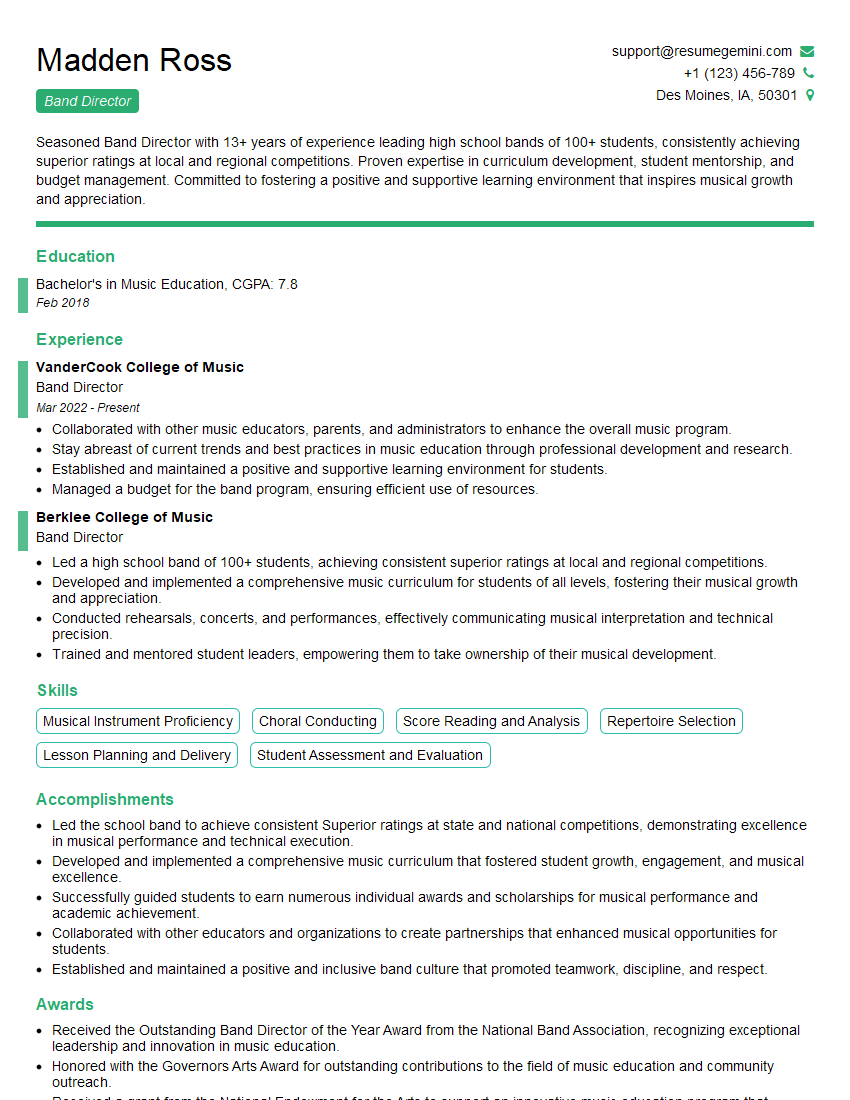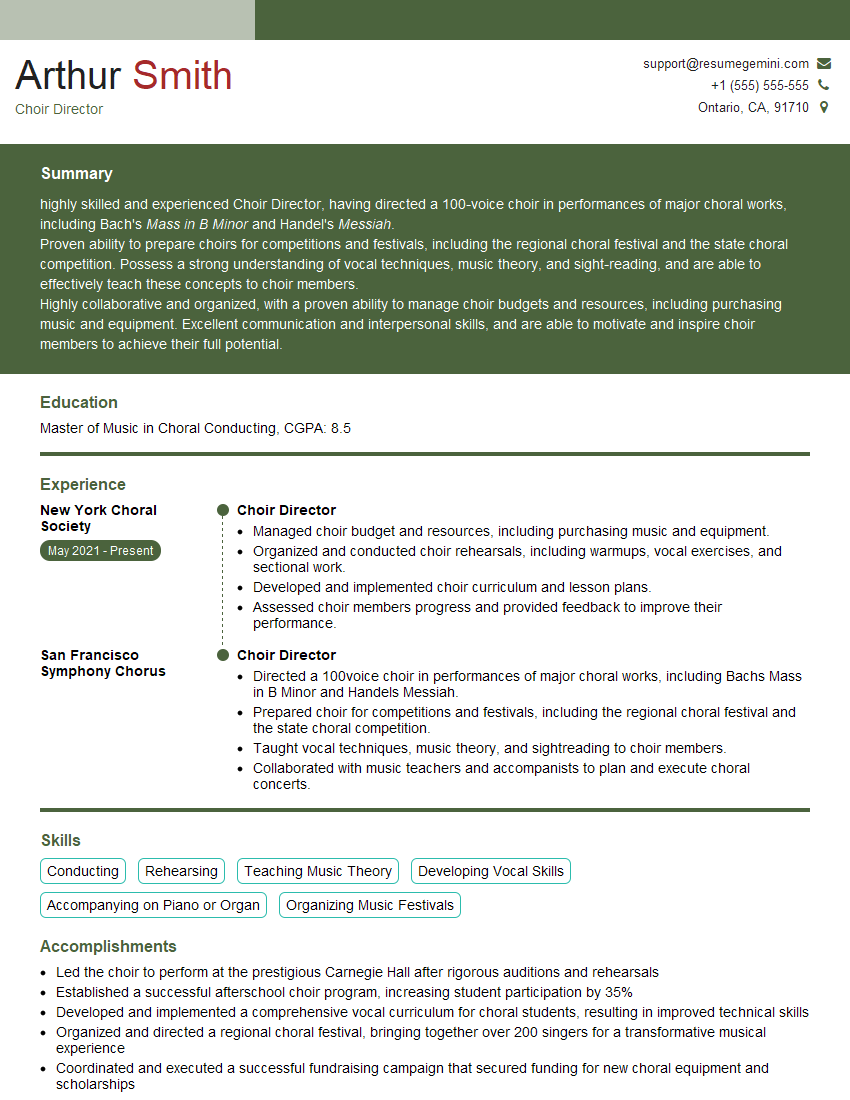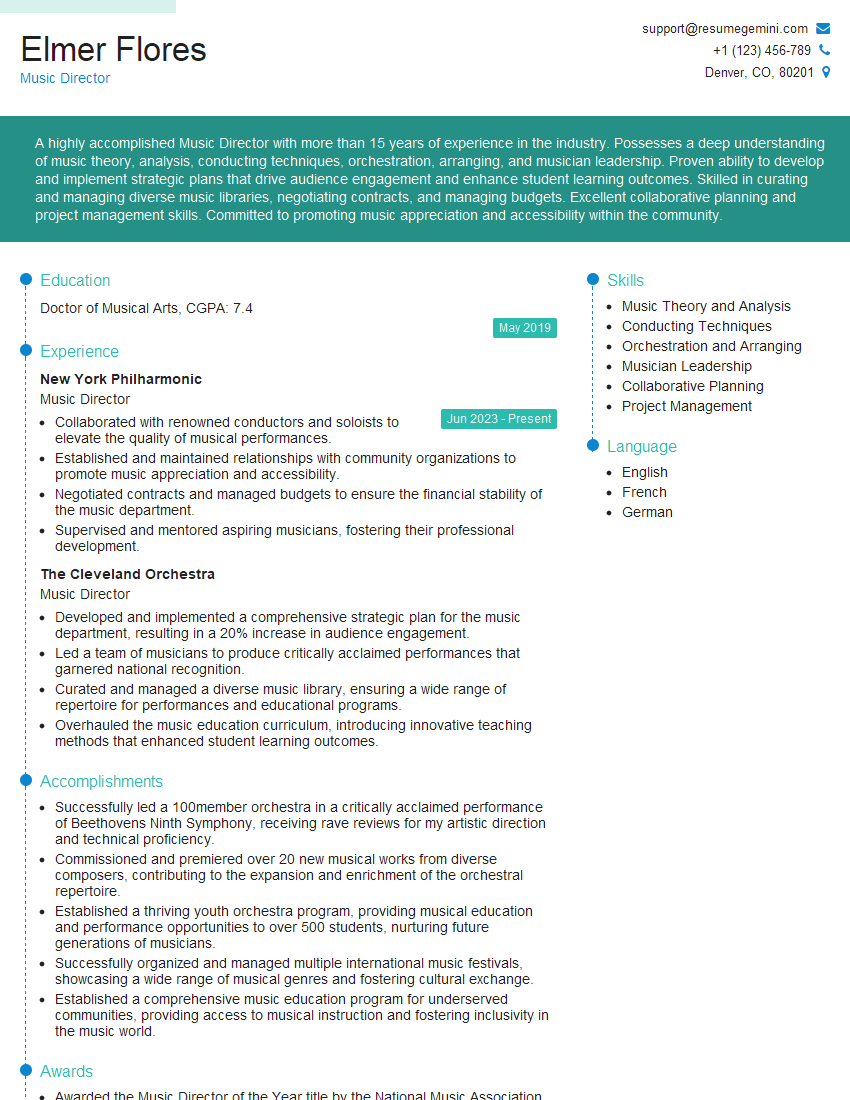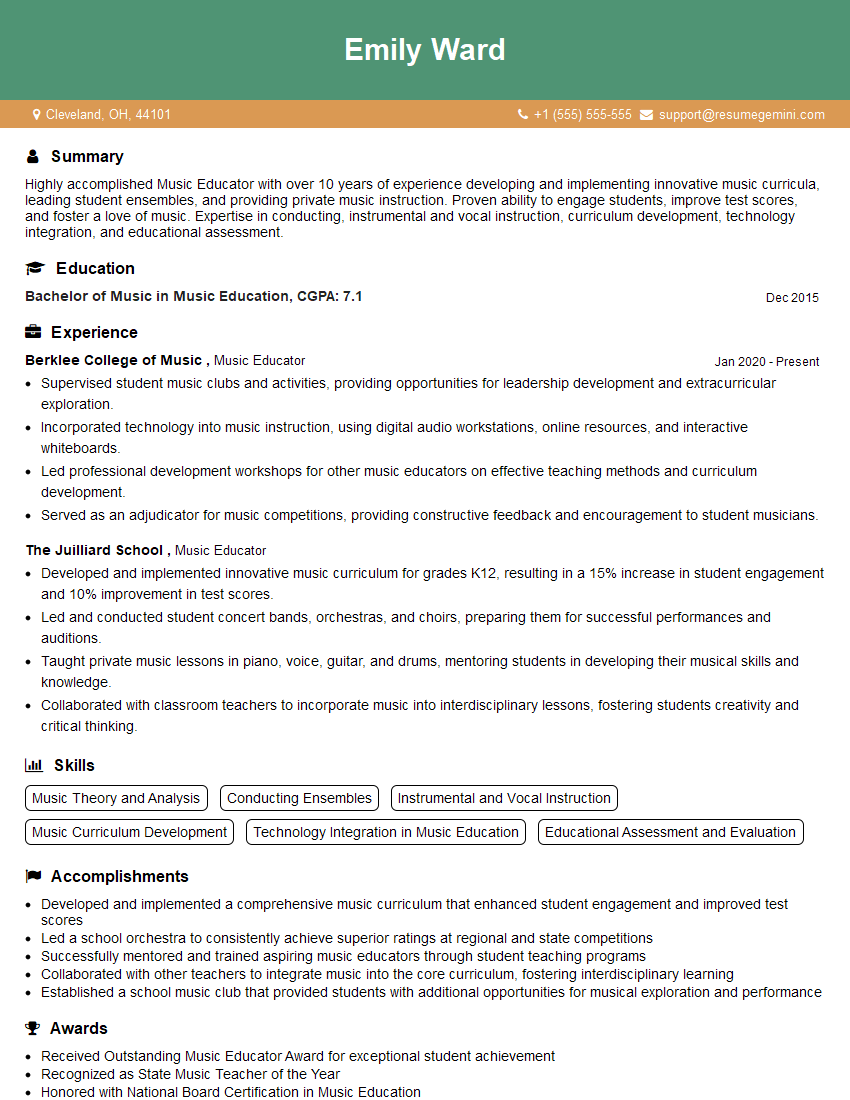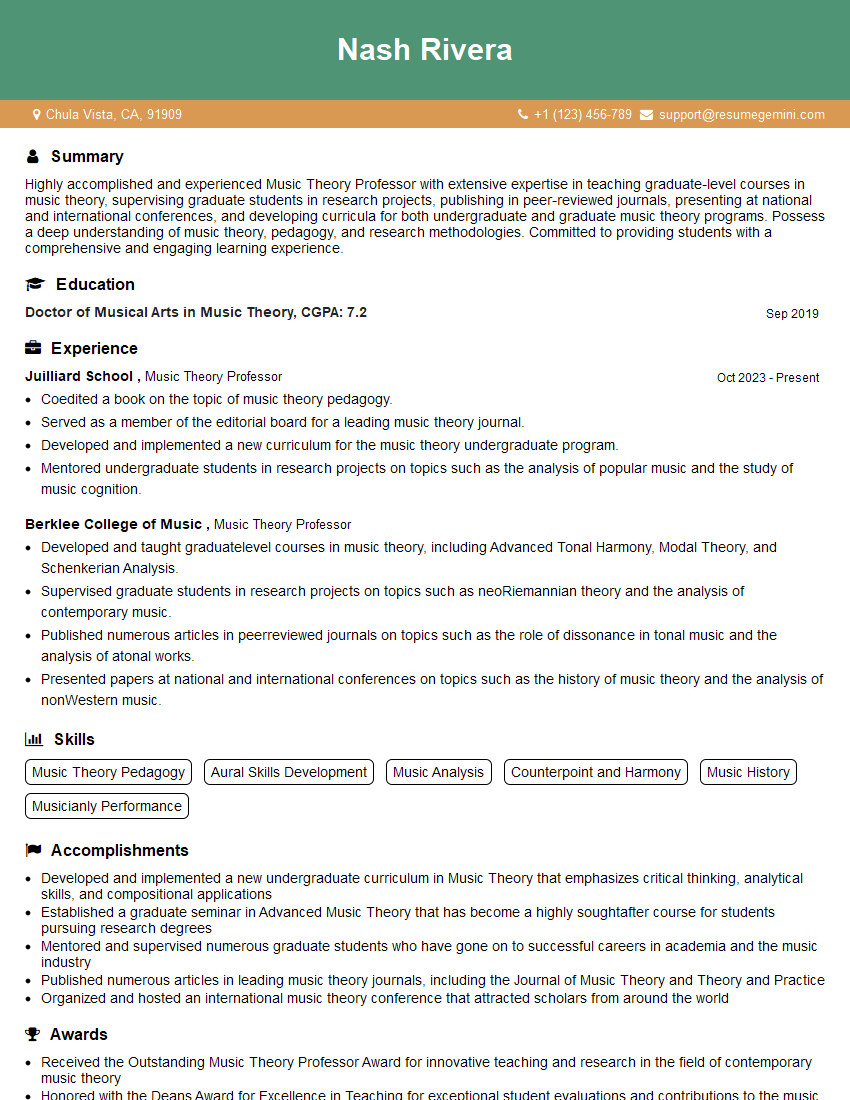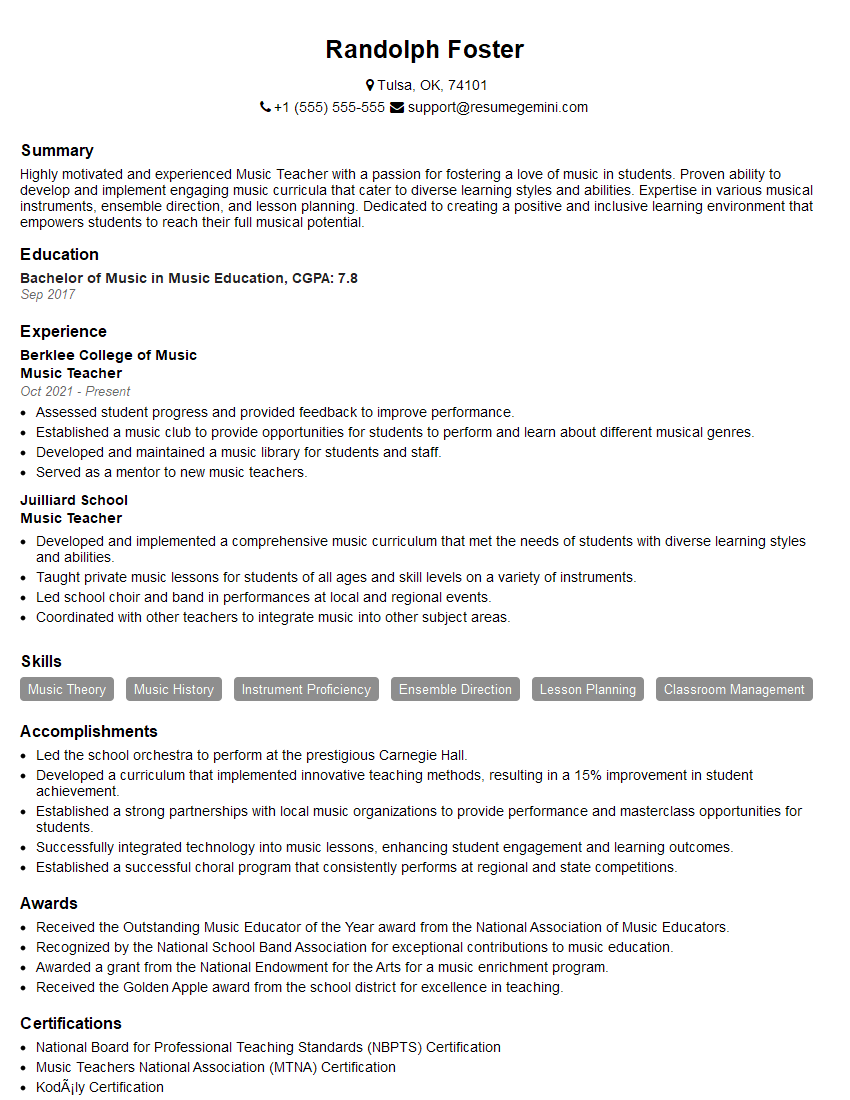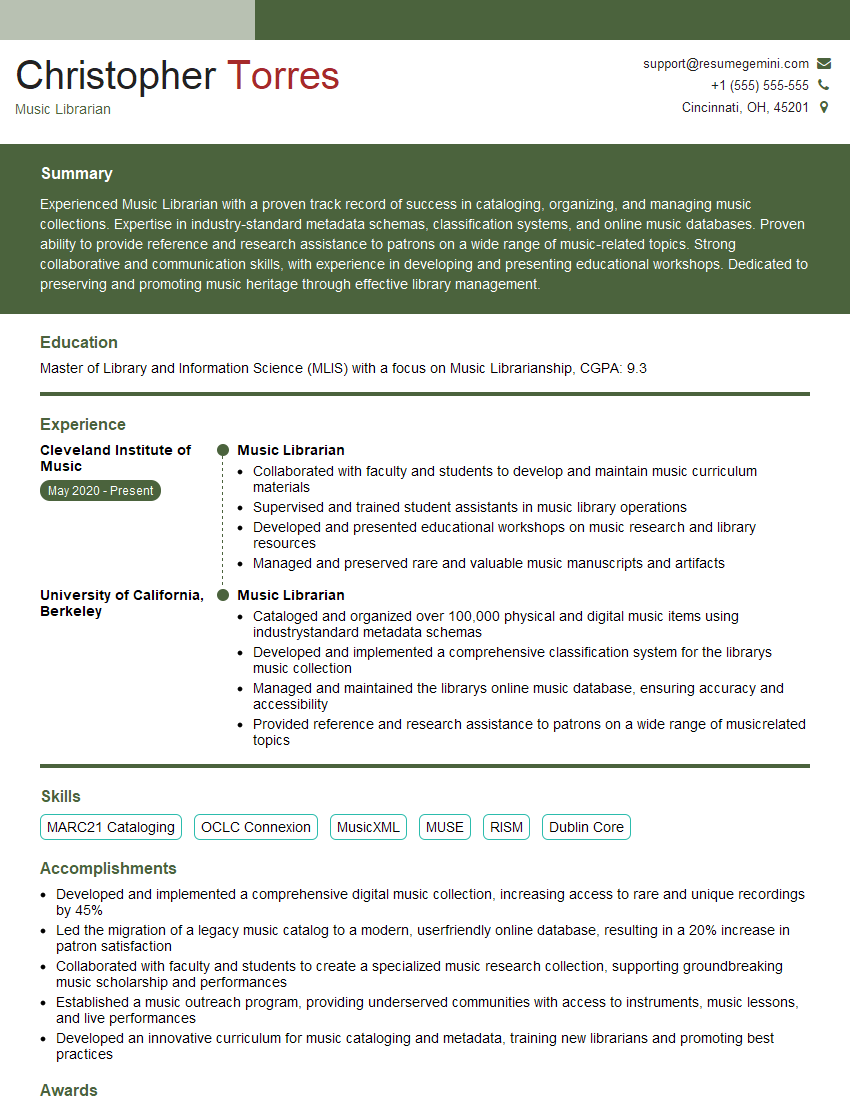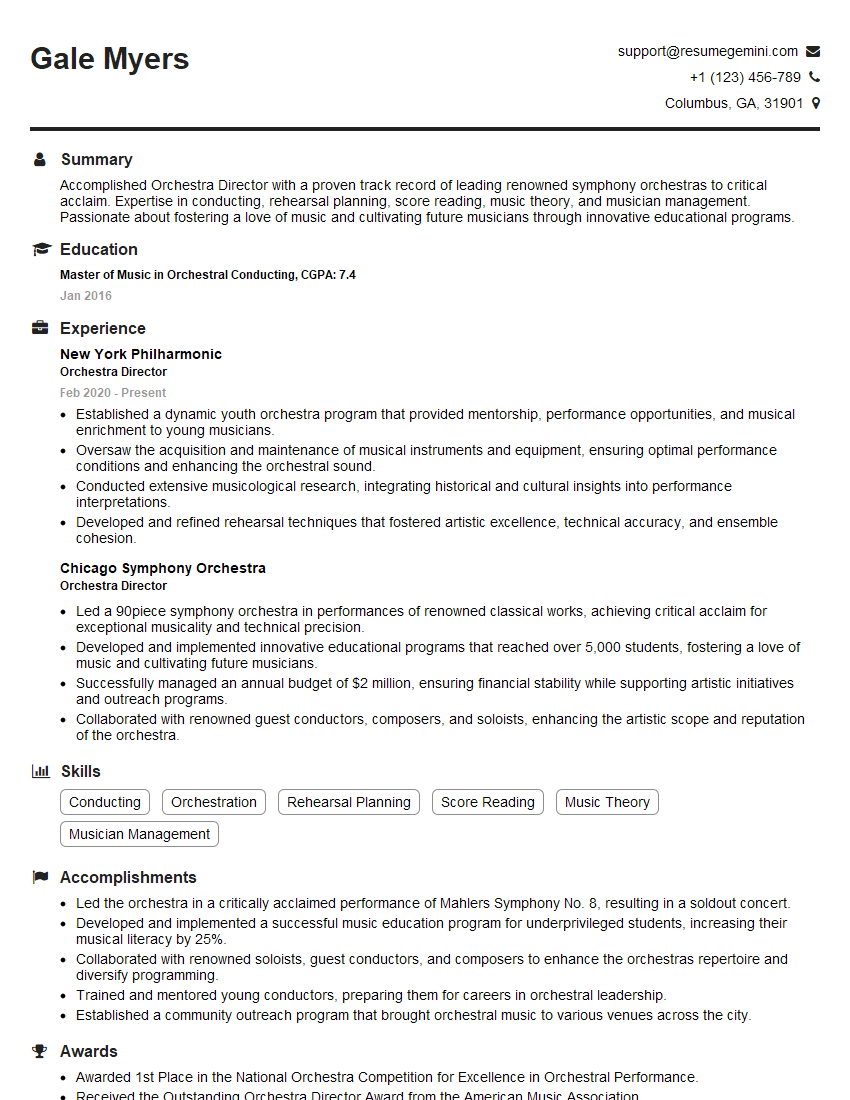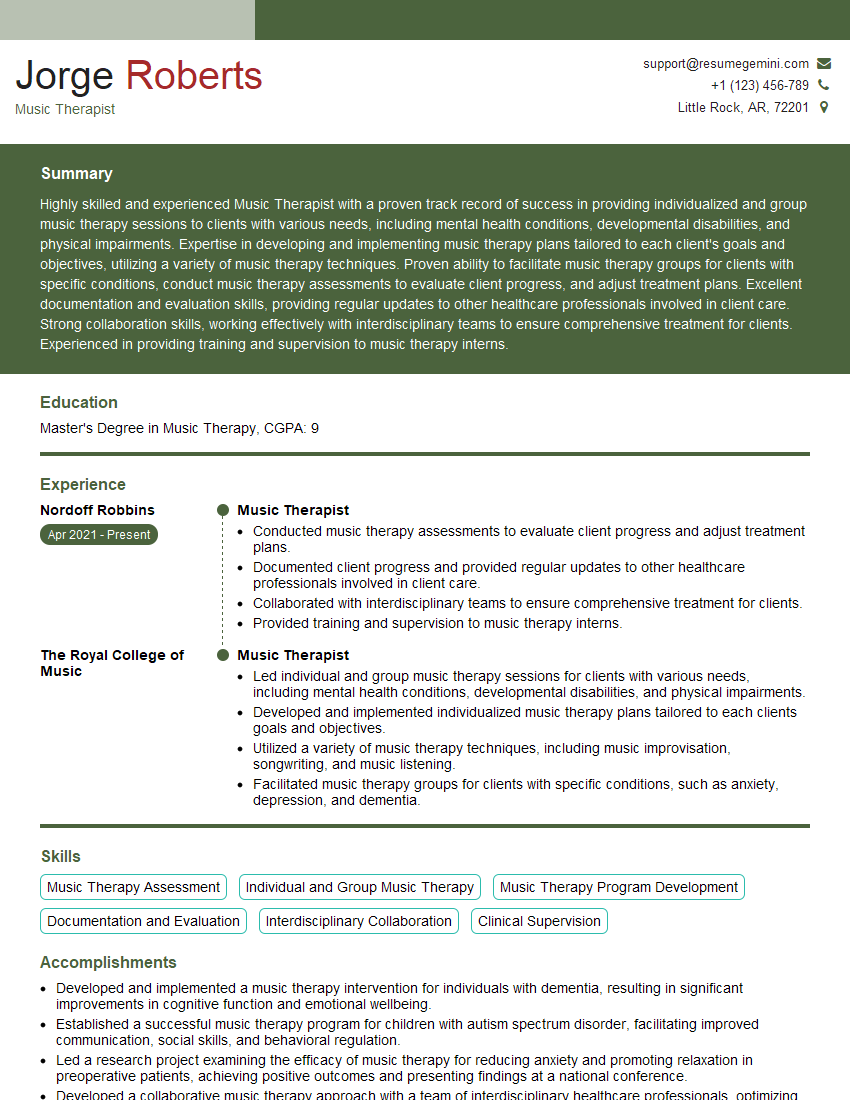Cracking a skill-specific interview, like one for Passion for Music and Education, requires understanding the nuances of the role. In this blog, we present the questions you’re most likely to encounter, along with insights into how to answer them effectively. Let’s ensure you’re ready to make a strong impression.
Questions Asked in Passion for Music and Education Interview
Q 1. Describe your teaching philosophy regarding music education.
My teaching philosophy centers on nurturing a lifelong love for music while developing essential musical skills. I believe music education should be holistic, encompassing not just technical proficiency but also creativity, critical thinking, collaboration, and self-expression. I strive to create a supportive and challenging environment where students feel empowered to explore their musical potential, regardless of their prior experience. My approach emphasizes active learning, individualized instruction tailored to each student’s needs, and a balance between structured learning and creative exploration. It’s about fostering a genuine appreciation for the art form, not just achieving technical mastery.
For example, I might introduce a new musical concept through a playful game, followed by structured practice, and then allow students to compose their own short pieces using the newly learned skills. This approach balances learning styles and ensures everyone participates.
Q 2. How do you adapt your teaching methods to different learning styles?
Recognizing that students learn in diverse ways, I adapt my teaching methods to cater to visual, auditory, and kinesthetic learners. For visual learners, I use diagrams, charts, and visual aids to illustrate musical concepts. Auditory learners benefit from listening exercises, discussions, and vocal practice. Kinesthetic learners engage through movement, playing instruments, and hands-on activities. I often incorporate all three learning styles within a single lesson.
For instance, when teaching rhythm, I might first visually demonstrate the rhythm on a whiteboard using notation, then have students clap and sing the rhythm (auditory), and finally have them act out the rhythm using body movements (kinesthetic).
Q 3. What strategies do you employ to foster a positive and inclusive classroom environment for music students?
Creating a positive and inclusive classroom is paramount. I foster respect for diverse musical tastes and backgrounds, encouraging students to share their own musical experiences and preferences. I use cooperative learning activities, where students work together on musical projects, to build teamwork and camaraderie. I actively address any instances of bullying or exclusion, promoting a culture of empathy and understanding. Celebrating the accomplishments of all students, regardless of skill level, is key to fostering a sense of belonging.
One effective strategy is to form small groups for ensemble work, allowing students to learn from each other and develop collaborative skills. This also naturally fosters a supportive environment, where students can provide and receive peer feedback.
Q 4. Explain your approach to assessing student progress in music.
Assessing student progress is a multifaceted process. I use a combination of formative and summative assessments. Formative assessments, such as informal observations during class and frequent quizzes, provide ongoing feedback and allow for adjustments in teaching. Summative assessments, including formal performances, written tests, and projects, evaluate overall learning outcomes. I also value self-assessment, encouraging students to reflect on their progress and identify areas for improvement.
For example, I might assess a student’s progress in playing a specific piece through a combination of observation during practice sessions, a short performance, and a self-assessment rubric where the student reflects on their technical accuracy and musical expression. This holistic approach gives a well-rounded picture of their development.
Q 5. How do you incorporate technology into your music instruction?
Technology plays a significant role in enhancing my music instruction. I use digital audio workstations (DAWs) like GarageBand or Ableton Live to allow students to compose and record their own music, fostering creativity and technological literacy. Interactive music software and apps provide engaging learning experiences. Online resources, such as music theory websites and video tutorials, supplement classroom instruction. I also utilize presentation software to create visually engaging lessons.
For example, students might use GarageBand to compose a song, then share their creations with the class. This allows for peer feedback and fosters a sense of accomplishment. The use of online resources helps personalize learning and caters to different learning styles.
Q 6. Describe your experience with different musical genres and styles.
My experience encompasses a wide range of musical genres and styles, including classical, jazz, pop, rock, folk, and world music. This breadth of knowledge allows me to cater to diverse student interests and expose them to a rich tapestry of musical traditions. I believe understanding the historical and cultural contexts of various genres is crucial for developing a well-rounded musical understanding.
In my teaching, I might use examples from different genres to illustrate musical concepts. For instance, I could use a jazz improvisation to demonstrate the concept of syncopation, or a pop song to illustrate songwriting techniques.
Q 7. How do you manage classroom behavior and ensure student engagement during music lessons?
Maintaining a positive and engaging classroom environment requires proactive strategies. I establish clear rules and expectations from the outset, using positive reinforcement to encourage desired behaviors. I incorporate a variety of activities and teaching methods to maintain student interest and prevent boredom. I also build rapport with students, creating a safe space where they feel comfortable expressing themselves and asking questions.
If a student displays disruptive behavior, I address it calmly and privately, focusing on finding solutions together. I create opportunities for students to take on leadership roles, such as assisting with classroom setup or leading a small group activity, increasing engagement and ownership.
Q 8. What are your methods for differentiating instruction to meet the needs of diverse learners in music?
Differentiated instruction in music education is crucial because students learn at different paces and have varying learning styles and strengths. My approach involves a multi-faceted strategy focusing on learning styles, musical aptitude, and individual needs.
Learning Styles: I cater to visual, auditory, and kinesthetic learners. For visual learners, I use diagrams, charts, and notation software. Auditory learners benefit from listening exercises, discussions, and singing. Kinesthetic learners learn best through movement, playing instruments, and hands-on activities like composing with manipulatives.
Musical Aptitude: I differentiate by grouping students based on their skill level for certain activities. Beginner students might focus on basic rhythm and melody exercises while more advanced students could compose short pieces or explore improvisation. This tiered approach allows me to tailor the challenge level to individual capabilities.
Individual Needs: I regularly assess student progress through observation, formative assessments (e.g., short quizzes, informal performances), and summative assessments (e.g., formal concerts, written tests). This helps me identify areas where students struggle and adjust my teaching accordingly. For students with learning disabilities, I might provide modified assignments, extra time, or assistive technology.
For example, in a lesson on rhythm, I might provide visual aids like rhythm trees for visual learners, rhythmic dictation exercises for auditory learners, and movement activities where students clap and stomp out rhythms for kinesthetic learners.
Q 9. How do you handle student performance anxiety?
Performance anxiety is a common challenge for music students. My approach involves creating a supportive and encouraging classroom environment where students feel comfortable taking risks.
Progressive Exposure: I gradually introduce performance opportunities, starting with smaller, informal settings, such as performing for classmates in small groups. This helps build confidence before larger, more formal performances.
Positive Reinforcement: I focus on celebrating effort and improvement rather than solely on perfection. I provide constructive feedback and emphasize the joy of making music.
Mindfulness and Relaxation Techniques: I introduce simple breathing and mindfulness exercises to help students manage their anxiety. This could involve deep breathing exercises before performances or guided imagery to visualize a successful performance.
Rehearsal and Preparation: Thorough rehearsal is key. I help students develop a strong sense of familiarity with their pieces, allowing them to focus on expression rather than memorization during the actual performance. I provide opportunities for mock performances.
For instance, if a student is anxious about a solo performance, we would start with practicing in front of a small group of trusted peers, then gradually increase the audience size before the actual performance. The focus remains on their progress and enjoyment of the process.
Q 10. Describe your experience collaborating with other teachers and staff members.
Collaboration is fundamental to effective teaching. I’ve collaborated extensively with other teachers and staff members, including classroom teachers, special education staff, and school counselors.
Classroom Teachers: I collaborate with classroom teachers to integrate music into other subjects, such as history, literature, or math. For instance, we might study a composer’s life in history class and then perform their music in music class.
Special Education Staff: I work closely with special education teachers to adapt music instruction to meet the needs of students with disabilities. This might involve modifying assignments, using assistive technology, or employing different teaching strategies.
School Counselors: I collaborate with counselors to support students’ social and emotional well-being. For instance, we might incorporate music therapy techniques or use music as a tool for self-expression and stress reduction.
A recent successful collaboration involved working with the drama teacher to create a musical theatre production, combining our expertise to enrich the learning experience for students involved.
Q 11. What is your approach to creating engaging and effective music lesson plans?
Engaging and effective music lesson plans are built upon a solid framework that balances theoretical understanding with practical application.
Clear Learning Objectives: Each lesson starts with clearly defined learning objectives that specify what students will learn and be able to do by the end of the lesson. These objectives should be measurable and aligned with curriculum standards.
Varied Activities: I incorporate a mix of activities, such as listening exercises, singing, playing instruments, composing, movement, and games. This keeps students engaged and caters to different learning styles.
Real-World Connections: Lessons should connect to students’ lives and experiences. For example, exploring different genres of music or incorporating current events related to music.
Assessment and Feedback: Formative assessment throughout the lesson helps me track student understanding and adjust my teaching as needed. Summative assessment at the end of the lesson or unit helps me evaluate overall learning.
A recent lesson plan on composing involved students using simple notation software to create their melodies and then performing them using classroom instruments. This combined theoretical understanding of musical notation with practical application and creative expression.
Q 12. How do you integrate music theory and practical application in your teaching?
Integrating music theory and practical application is crucial for developing well-rounded musicians. I use a holistic approach where theory is not taught in isolation but rather as a tool for understanding and creating music.
Theory in Practice: I introduce theoretical concepts within the context of practical activities. For example, when teaching about major and minor scales, we would learn the scales and then use them to improvise melodies or compose short pieces. We’d analyze existing songs to identify scales and chords used.
Active Learning: I encourage active learning through activities such as analyzing musical scores, composing, arranging, and improvising. This reinforces theoretical concepts while building practical skills.
Real-World Examples: I use real-world examples of music to illustrate theoretical concepts. For example, listening to pieces in different keys to understand the effect of key changes or analyzing pop songs to identify chord progressions.
For instance, after teaching about harmony, we’d analyze a simple song, identifying the chords and their function. Then, students would try to create their simple harmonic progressions and build simple songs.
Q 13. Explain your experience using various teaching resources and materials.
I utilize a variety of teaching resources and materials to cater to diverse learning styles and needs.
Technology: I incorporate technology such as notation software (e.g., Sibelius, MuseScore), music creation software (e.g., GarageBand, Ableton Live), and online music libraries. This allows for interactive learning and personalized music creation.
Traditional Materials: I also use traditional materials such as sheet music, textbooks, workbooks, and various instruments. This provides a balance between traditional and modern teaching methods.
Authentic Materials: I use authentic musical materials, such as recordings of live performances, interviews with musicians, and historical documents. This brings the subject to life and provides a wider context.
For instance, in a unit on jazz, we’d listen to original recordings by famous musicians, explore their history through online resources, and even try to imitate their styles using classroom instruments.
Q 14. How do you incorporate music history into your curriculum?
Music history is integrated into my curriculum to provide students with a broader understanding of the context in which music is created and performed.
Chronological Approach: I introduce music history in a chronological manner, tracing the evolution of musical styles and genres. This gives students a sense of the historical context.
Thematic Approach: I also use a thematic approach, focusing on specific topics or composers. For instance, I could dedicate a unit to the Baroque period or focus on the life and works of a specific composer like Beethoven.
Cultural Context: I emphasize the cultural context of music, exploring how music reflects the social, political, and economic environment of its time. We would investigate the influences on music of various regions and cultures.
Connecting History to Practice: I connect historical music with contemporary practices. We listen to historical recordings and compare and contrast them with modern versions of the same pieces or similar styles.
For example, when studying the classical period, we’d listen to examples of symphonies by Mozart and Haydn and analyze their structure. Then, we’d discuss the cultural context of the time and its influences on music composition.
Q 15. How do you assess a student’s musical aptitude and potential?
Assessing a student’s musical aptitude and potential is a multifaceted process that goes beyond simply judging their technical skills. It involves observing their natural abilities, their passion for music, and their learning style.
- Aural Skills Tests: I assess their ability to recognize and reproduce melodic and rhythmic patterns, their sense of pitch and rhythm, and their ability to identify intervals and chords. This can involve simple dictation exercises or playing short melodic fragments and asking them to sing them back.
- Performance Observation: I observe their playing or singing technique, their musicality (expressiveness, phrasing, dynamics), and their overall comfort and engagement with the instrument or vocal performance. Watching them improvise, if appropriate for their level, can reveal a great deal about their creative potential.
- Theoretical Knowledge: Depending on their level, I evaluate their understanding of music theory concepts, such as notation, scales, chords, and basic music history. This isn’t necessarily about rote memorization but about their ability to understand musical structure and context.
- Personal Interaction: Crucially, I observe their attitude towards music, their enthusiasm, and their willingness to learn. A student’s dedication and intrinsic motivation are powerful predictors of their future success.
For example, a student might score highly on aural tests but show less enthusiasm for practicing. This suggests a need to cultivate their passion alongside developing their technical abilities. Conversely, a student with incredible passion but lacking technical proficiency could benefit from targeted skill-building exercises and tailored feedback. A holistic approach is key.
Career Expert Tips:
- Ace those interviews! Prepare effectively by reviewing the Top 50 Most Common Interview Questions on ResumeGemini.
- Navigate your job search with confidence! Explore a wide range of Career Tips on ResumeGemini. Learn about common challenges and recommendations to overcome them.
- Craft the perfect resume! Master the Art of Resume Writing with ResumeGemini’s guide. Showcase your unique qualifications and achievements effectively.
- Don’t miss out on holiday savings! Build your dream resume with ResumeGemini’s ATS optimized templates.
Q 16. Describe your experience with music performance assessment and adjudication.
My experience in music performance assessment and adjudication spans over [Number] years, encompassing diverse settings such as school concerts, regional competitions, and festivals. I’ve adjudicated performances across various instrumental and vocal genres, from classical to jazz to contemporary music.
My assessment criteria are always clearly defined and communicated beforehand to participants and parents. These criteria typically include technical proficiency (accuracy, intonation, rhythm), musicality (interpretation, phrasing, dynamics, expression), and stage presence (confidence, connection with the audience). I provide constructive feedback that focuses not just on areas needing improvement, but also highlights strengths and areas of excellence. This feedback is always delivered in a supportive and encouraging manner, aiming to promote growth and confidence.
One particularly memorable experience was judging a regional competition for young pianists. A student who didn’t win first place showed exceptional creativity and individuality in their interpretation of a challenging piece. In my feedback, I highlighted this unique approach and encouraged them to continue exploring their musical voice. Seeing the impact of such specific, positive feedback is very rewarding.
Q 17. How do you foster creativity and innovation in your music students?
Fostering creativity and innovation in music students requires a balanced approach that combines structured learning with opportunities for self-expression and exploration.
- Improvisation Exercises: Regular improvisation sessions, starting with simple melodic exercises and progressing to more complex harmonic explorations, are crucial. These activities stimulate spontaneous musical idea generation and develop creative problem-solving skills.
- Composition Projects: I encourage students to compose their own pieces, starting with simple melodies and harmonies and gradually working towards more sophisticated forms. This involves using different technologies and software to aid the composition process, such as GarageBand or Music notation software.
- Open-Ended Assignments: Instead of assigning pre-determined pieces, I often present students with open-ended assignments, such as ‘compose a piece expressing a specific emotion’ or ‘improvise a piece based on a given rhythmic pattern’. This allows them to explore their own creativity freely.
- Collaboration and Peer Learning: Group projects and collaborative compositions provide a platform for students to learn from each other, share ideas, and develop a sense of collective creativity. This often leads to unexpected and innovative musical outcomes.
For instance, in a recent composition project, a student created a piece using found sounds combined with traditional instrumental parts. This unexpected approach was both innovative and effective. Such moments highlight the importance of providing a supportive environment where students feel empowered to take risks and experiment with their musical ideas.
Q 18. How do you address challenges related to funding and resource limitations in music education?
Addressing funding and resource limitations in music education requires resourcefulness and a collaborative approach.
- Grant Applications: I actively seek out grants and funding opportunities from various organizations and foundations that support music education. This involves writing compelling grant proposals that highlight the program’s impact and need for funding.
- Community Partnerships: I build strong relationships with local businesses and community organizations to secure sponsorships, donations, or in-kind contributions (instruments, equipment, etc.).
- Fundraising Events: Organizing concerts, recitals, and other fundraising events allows me to engage the community directly and raise funds to support the program.
- Creative Resourcefulness: I utilize free or low-cost resources, such as online educational platforms, open-source software, and readily available materials for creating DIY musical instruments.
- Advocacy: I advocate for increased funding for music education at both the school and district levels, emphasizing the importance of music for holistic child development.
For example, I successfully secured a grant to purchase new musical instruments for our school band. This demonstrated the power of proactive fundraising and community engagement in overcoming resource limitations. The joy of the students using their new instruments was a powerful testament to the success of this collaborative effort.
Q 19. What are your professional development goals in music education?
My professional development goals in music education focus on continually enhancing my skills and knowledge to provide the best possible musical experience for my students.
- Advanced Music Theory and Pedagogy: I plan to pursue further studies in advanced music theory and pedagogy to deepen my understanding of musical concepts and refine my teaching methods. I am particularly interested in exploring [Specific Area of Interest in Music Theory/Pedagogy].
- Technology Integration in Music Education: I aim to enhance my proficiency in using technology to enhance the learning experience, such as incorporating music software, digital audio workstations (DAWs), and online learning platforms into my teaching.
- Inclusive Music Education Practices: I’m committed to further developing my expertise in working with students with diverse learning needs and abilities, ensuring that music education is accessible to everyone.
- Music Therapy Techniques: I’m exploring the integration of music therapy techniques into my teaching to improve the therapeutic effects of music and create a positive and inclusive music learning environment.
By pursuing these goals, I strive to remain a knowledgeable, innovative, and effective music educator.
Q 20. Describe your experience working with students with special needs in a music setting.
Working with students with special needs in a music setting requires a flexible and individualized approach that adapts to each student’s unique strengths and challenges.
My experience has taught me that music can be a powerful tool for inclusion and therapeutic intervention. I utilize adaptive teaching strategies, modified instruments, and assistive technologies to ensure accessibility for all students. I collaborate closely with special education teachers, therapists, and parents to develop individualized education plans (IEPs) that cater to each student’s specific learning style and needs.
For example, I worked with a student with autism who had difficulty with social interaction. Through music therapy techniques, we created a structured and predictable musical environment, using repetitive patterns and routines to build confidence and comfort. The student responded exceptionally well, demonstrating improved communication and social skills. This experience showed the unique potential music has for reaching students with diverse needs.
Q 21. How do you build strong relationships with parents and guardians?
Building strong relationships with parents and guardians is essential for creating a supportive and collaborative learning environment.
- Open Communication: I maintain open and consistent communication with parents through regular updates on their child’s progress, both strengths and areas needing attention. This includes email updates, parent-teacher conferences, and informal conversations.
- Active Listening: I actively listen to parents’ concerns and perspectives, valuing their input and incorporating it into the teaching process whenever possible. I believe parents are partners in their child’s education.
- Transparency: I ensure transparency in my teaching methods, assessment criteria, and expectations for student performance. This includes explaining assessment and grading procedures clearly.
- Shared Goals: I work collaboratively with parents to establish shared goals for their child’s musical development, ensuring alignment between home and school practices. This may include providing specific practice suggestions tailored to the family’s capabilities.
For instance, I’ve worked with parents who have concerns about their child’s practice habits. Through open communication, we established a clear practice plan, monitored progress together, and celebrated milestones achieved. This collaborative approach fostered a strong sense of teamwork and mutual support, creating a positive and effective learning environment for the student.
Q 22. What strategies do you use to encourage student participation and involvement in music activities?
Encouraging student participation in music is crucial for fostering a love of music and developing their skills. My strategy is multifaceted, focusing on creating a positive and inclusive classroom environment where every student feels comfortable contributing.
Variety of Activities: I incorporate diverse activities beyond traditional lessons, including ensemble work, songwriting, improvisation, music technology projects, and listening activities tailored to different learning styles. For example, I might have students compose short melodies using GarageBand, fostering creativity and digital literacy.
Student Choice and Ownership: I offer students choices in their learning whenever possible. This could involve selecting pieces to perform, choosing instruments to explore, or contributing to the design of class projects. This sense of ownership boosts engagement.
Positive Reinforcement and Feedback: I focus on praising effort and progress rather than solely on achievement. I provide constructive feedback, celebrating small wins and building students’ confidence gradually. A simple ‘Well done on your effort’ can go a long way.
Collaboration and Peer Learning: I design group activities that encourage collaboration and peer learning. This allows students to learn from each other, share their knowledge, and build a sense of community within the classroom. A group project where students create a musical arrangement together enhances teamwork.
Performance Opportunities: Providing regular opportunities for performance, whether it’s a small class concert or participation in school events, helps motivate students and showcase their progress. This creates a sense of accomplishment and boosts morale.
Q 23. How do you maintain your own professional development and passion for music?
Maintaining my passion and professional development in music requires a conscious and ongoing effort. It’s a lifelong journey, not a destination.
Continuing Education: I regularly attend workshops, conferences, and masterclasses to learn new teaching techniques and stay updated on current trends in music education. Recently, I participated in a workshop on incorporating technology into music education.
Mentorship and Collaboration: I actively seek mentorship from experienced music educators and collaborate with colleagues to share best practices and learn from each other’s experiences. I regularly meet with a mentor to discuss challenges and strategies.
Personal Musical Exploration: I actively engage in my own musical pursuits, whether it’s performing in a local band, composing music, or simply listening to a wide variety of genres. This keeps my passion alive and informs my teaching.
Staying Current: I stay informed about new music, technologies, and research related to music education through reading professional journals, attending concerts and listening to podcasts.
Q 24. Describe a time you had to resolve a conflict between students in a music class.
In one instance, two students clashed over their roles in a band project. One felt they were carrying the other, while the other felt their contribution wasn’t valued. I addressed this by facilitating a mediated conversation.
Active Listening: I listened to each student separately to understand their perspectives without judgment, allowing them to express their feelings freely.
Identifying the Root Cause: I helped them identify the underlying issue—a misunderstanding of roles and responsibilities within the group.
Collaborative Solution: I then guided them towards a collaborative solution. We re-defined roles, ensuring each student had clear responsibilities and a voice in decision-making. We also established clear communication protocols to prevent future conflicts.
Monitoring and Follow-up: I monitored their progress on the project and provided support to ensure the collaboration ran smoothly. I also checked in to ensure that their understanding of roles and responsibilities were clearly defined and met.
This approach emphasized communication, empathy, and collaborative problem-solving, teaching them valuable conflict resolution skills applicable beyond the classroom.
Q 25. How do you incorporate student feedback into your teaching practices?
Student feedback is invaluable for refining my teaching practices. I incorporate it in several ways.
Regular Feedback Mechanisms: I use various methods to gather student feedback including informal discussions, short surveys, anonymous suggestion boxes, and end-of-term evaluations.
Analyzing Feedback Data: I meticulously analyze the feedback to identify recurring themes, areas of strength, and areas needing improvement in my teaching methods and curriculum design.
Actionable Changes: I use the feedback to make actionable changes to my teaching. For example, if students consistently mention a lack of clarity in explanations, I might revise my lesson plans to incorporate more visual aids or interactive activities.
Open Communication: I foster an open communication environment where students feel comfortable sharing their feedback throughout the term, not just at the end. This allows for timely adjustments to teaching strategies.
Q 26. How do you balance the demands of teaching with other responsibilities?
Balancing teaching with other responsibilities requires effective time management and prioritization.
Detailed Planning: I create detailed lesson plans and a weekly schedule that allocates specific time slots for lesson preparation, grading, administrative tasks, and personal time. I use digital calendars and to-do lists to stay organized.
Prioritization: I prioritize tasks based on urgency and importance, focusing on activities that directly impact student learning. I utilize the Eisenhower Matrix (Urgent/Important) to manage my workload.
Delegation: Where possible, I delegate tasks or seek assistance from colleagues or support staff. This frees up time for more crucial aspects of my work.
Self-Care: I make sure to include time for personal well-being. This is essential for preventing burnout and maintaining my energy levels. Regular exercise and hobbies are critical.
Q 27. Describe your experience with using various musical instruments.
My musical experience spans several instruments. I’m proficient in piano (my primary instrument), and I have intermediate skills on guitar and ukulele. I also have experience conducting and a basic understanding of percussion. This diverse background allows me to provide a well-rounded musical education to my students.
My experience isn’t just about technical proficiency; it’s also about understanding the nuances of different instruments and how they contribute to a musical ensemble. This understanding helps me better guide my students in their instrumental choices and performance.
Q 28. What are your thoughts on the role of music in holistic child development?
Music plays a vital role in holistic child development. It’s far more than just learning to play an instrument.
Cognitive Development: Music enhances memory, concentration, and problem-solving skills. Learning music notation, for example, strengthens cognitive abilities.
Emotional Development: Music provides an outlet for self-expression, helping children process emotions and develop emotional intelligence. Expressing feelings through music can be therapeutic.
Social Development: Ensemble playing fosters teamwork, collaboration, and communication skills. It teaches children to work together towards a common goal.
Creative Development: Music nurtures creativity and imagination, allowing children to explore their artistic potential through composition, improvisation, and performance. Music is a powerful creative outlet.
By integrating music into a child’s education, we nurture their cognitive, emotional, social, and creative development, fostering well-rounded individuals.
Key Topics to Learn for Passion for Music and Education Interview
- Pedagogical Approaches: Explore various teaching methodologies, including learner-centered, inquiry-based, and differentiated instruction, and their application in music education.
- Curriculum Development: Understand the principles of creating engaging and effective music curricula aligned with learning objectives and student needs. Consider diverse learning styles and abilities.
- Music Theory and History: Demonstrate a solid understanding of fundamental music theory concepts and the historical context of various musical styles and periods. Be prepared to discuss their relevance to teaching.
- Classroom Management and Student Engagement: Discuss strategies for creating a positive and productive learning environment, managing student behavior effectively, and fostering student participation and creativity.
- Assessment and Evaluation: Familiarize yourself with different assessment methods for evaluating student progress in music, including both formative and summative assessments. Be prepared to discuss the importance of providing constructive feedback.
- Technology Integration: Explore how technology can enhance music education, such as using digital audio workstations (DAWs), music notation software, and online learning platforms.
- Diversity, Equity, and Inclusion: Discuss the importance of creating an inclusive classroom environment that celebrates diverse musical traditions and experiences. Understand strategies to address potential biases in music education.
- Professional Development: Show awareness of the ongoing need for professional growth in music education and your commitment to continuous learning and improvement.
Next Steps
Mastering the principles of Passion for Music and Education is crucial for career advancement in this rewarding field. A strong foundation in pedagogy, curriculum development, and classroom management will set you apart. To significantly increase your job prospects, invest time in crafting an ATS-friendly resume that highlights your skills and experience effectively. ResumeGemini is a trusted resource to help you build a professional and impactful resume. Examples of resumes tailored to Passion for Music and Education are available to help guide you. Take advantage of these resources to present yourself confidently to potential employers.
Explore more articles
Users Rating of Our Blogs
Share Your Experience
We value your feedback! Please rate our content and share your thoughts (optional).
What Readers Say About Our Blog
Hello,
We found issues with your domain’s email setup that may be sending your messages to spam or blocking them completely. InboxShield Mini shows you how to fix it in minutes — no tech skills required.
Scan your domain now for details: https://inboxshield-mini.com/
— Adam @ InboxShield Mini
Reply STOP to unsubscribe
Hi, are you owner of interviewgemini.com? What if I told you I could help you find extra time in your schedule, reconnect with leads you didn’t even realize you missed, and bring in more “I want to work with you” conversations, without increasing your ad spend or hiring a full-time employee?
All with a flexible, budget-friendly service that could easily pay for itself. Sounds good?
Would it be nice to jump on a quick 10-minute call so I can show you exactly how we make this work?
Best,
Hapei
Marketing Director
Hey, I know you’re the owner of interviewgemini.com. I’ll be quick.
Fundraising for your business is tough and time-consuming. We make it easier by guaranteeing two private investor meetings each month, for six months. No demos, no pitch events – just direct introductions to active investors matched to your startup.
If youR17;re raising, this could help you build real momentum. Want me to send more info?
Hi, I represent an SEO company that specialises in getting you AI citations and higher rankings on Google. I’d like to offer you a 100% free SEO audit for your website. Would you be interested?
Hi, I represent an SEO company that specialises in getting you AI citations and higher rankings on Google. I’d like to offer you a 100% free SEO audit for your website. Would you be interested?
good
